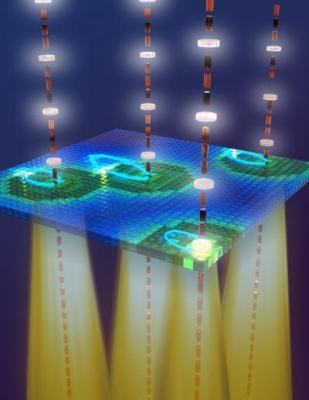UC Santa Barbara’s physicists have observed the emergence of multi-colored lights. The researchers, based on the concentration of high- and low-frequency laser beams in a semiconductor, induced the electrons to explode from their cores, followed by rapid progression, and returning back into the cores.
 This is an artist's rendition of electron-hole recollision. Near infrared (amber rods) and terahertz (yellow cones) radiation interact with a semiconductor quantum well (tiles) Credit: Peter Allen, UCSB
This is an artist's rendition of electron-hole recollision. Near infrared (amber rods) and terahertz (yellow cones) radiation interact with a semiconductor quantum well (tiles) Credit: Peter Allen, UCSB
Due to this recollision, there is simultaneous generation of light at multiple frequencies. The researchers’ observation has been published in the science journal, Nature.
When the semiconductor material such as gallium arsenide nanostructures is hit by an optical laser beam of high-frequency, an electron-hole pair named exciton will be produced. The hole will be positively charged, whereas negative charge is imparted on the electron. A strong mutual attraction bond exists between the electron and the hole.
The phenomenon of electron-hole recollision is capable of accelerating data transfer and communication processes, significantly for real-world applications. The major applications include high-speed modulation and multiplexing, a potential to transmit data down to multiple channels. The phenomenon of electron-hole recollision generates light at new frequencies, within which an optimal separation exists.
The electron-hole recollisions were created by the UCSB physicists using a free electron laser, which is a massive machine placed in UCSB's Broida Hall.
According to the researchers, the recollisions produced through this method may not support real-world applications. However, by replacing a transistor instead of the free electron laser, strong terahertz fields can be generated.